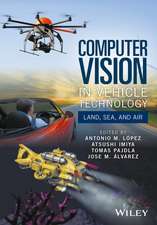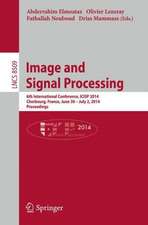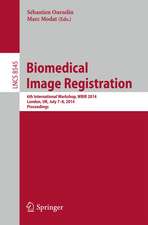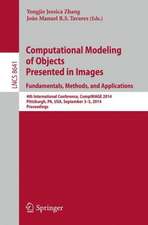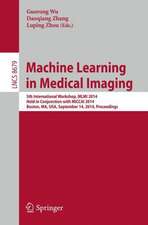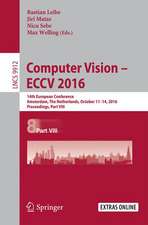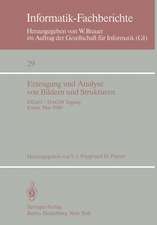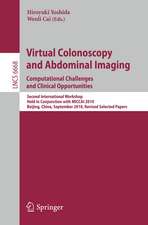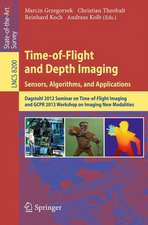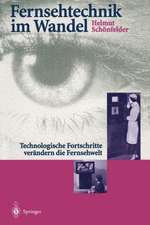Computer Vision - ECCV 2004: 8th European Conference on Computer Vision, Prague, Czech Republic, May 11-14, 2004. Proceedings, Part IV: Lecture Notes in Computer Science, cartea 3024
Editat de Tomas Pajdla, Jiri Matasen Limba Engleză Paperback – 28 apr 2004
| Toate formatele și edițiile | Preț | Express |
|---|---|---|
| Paperback (4) | 627.34 lei 38-44 zile | |
| Springer Berlin, Heidelberg – 28 apr 2004 | 627.34 lei 38-44 zile | |
| Springer Berlin, Heidelberg – 30 apr 2004 | 639.01 lei 38-44 zile | |
| Springer Berlin, Heidelberg – 28 apr 2004 | 665.93 lei 6-8 săpt. | |
| Springer Berlin, Heidelberg – 28 apr 2004 | 670.22 lei 6-8 săpt. |
Din seria Lecture Notes in Computer Science
- 20%
 Preț: 1061.55 lei
Preț: 1061.55 lei - 20%
 Preț: 307.71 lei
Preț: 307.71 lei - 20%
 Preț: 438.69 lei
Preț: 438.69 lei - 20%
 Preț: 579.30 lei
Preț: 579.30 lei -
 Preț: 410.88 lei
Preț: 410.88 lei - 17%
 Preț: 427.22 lei
Preț: 427.22 lei - 20%
 Preț: 596.46 lei
Preț: 596.46 lei - 15%
 Preț: 448.04 lei
Preț: 448.04 lei - 20%
 Preț: 353.50 lei
Preț: 353.50 lei -
 Preț: 389.49 lei
Preț: 389.49 lei - 20%
 Preț: 309.90 lei
Preț: 309.90 lei - 20%
 Preț: 645.28 lei
Preț: 645.28 lei - 20%
 Preț: 763.23 lei
Preț: 763.23 lei - 15%
 Preț: 580.46 lei
Preț: 580.46 lei - 20%
 Preț: 310.28 lei
Preț: 310.28 lei - 20%
 Preț: 655.02 lei
Preț: 655.02 lei - 20%
 Preț: 1183.14 lei
Preț: 1183.14 lei - 20%
 Preț: 340.32 lei
Preț: 340.32 lei -
 Preț: 449.57 lei
Preț: 449.57 lei - 20%
 Preț: 591.51 lei
Preț: 591.51 lei - 18%
 Preț: 938.83 lei
Preț: 938.83 lei - 20%
 Preț: 337.00 lei
Preț: 337.00 lei - 20%
 Preț: 649.50 lei
Preț: 649.50 lei - 20%
 Preț: 607.40 lei
Preț: 607.40 lei - 20%
 Preț: 1414.79 lei
Preț: 1414.79 lei - 20%
 Preț: 1024.44 lei
Preț: 1024.44 lei - 20%
 Preț: 583.40 lei
Preț: 583.40 lei - 20%
 Preț: 453.32 lei
Preț: 453.32 lei - 20%
 Preț: 575.49 lei
Preț: 575.49 lei - 20%
 Preț: 1075.26 lei
Preț: 1075.26 lei - 20%
 Preț: 585.88 lei
Preț: 585.88 lei - 20%
 Preț: 825.93 lei
Preț: 825.93 lei - 17%
 Preț: 360.20 lei
Preț: 360.20 lei - 20%
 Preț: 763.23 lei
Preț: 763.23 lei - 20%
 Preț: 340.32 lei
Preț: 340.32 lei - 20%
 Preț: 504.58 lei
Preț: 504.58 lei - 20%
 Preț: 369.13 lei
Preț: 369.13 lei - 20%
 Preț: 580.93 lei
Preț: 580.93 lei - 20%
 Preț: 343.62 lei
Preț: 343.62 lei - 20%
 Preț: 350.21 lei
Preț: 350.21 lei - 20%
 Preț: 583.40 lei
Preț: 583.40 lei - 20%
 Preț: 583.40 lei
Preț: 583.40 lei - 15%
 Preț: 438.59 lei
Preț: 438.59 lei - 20%
 Preț: 341.95 lei
Preț: 341.95 lei - 20%
 Preț: 238.01 lei
Preț: 238.01 lei - 20%
 Preț: 538.30 lei
Preț: 538.30 lei
Preț: 627.34 lei
Preț vechi: 784.18 lei
-20% Nou
Puncte Express: 941
Preț estimativ în valută:
120.06€ • 124.88$ • 99.11£
120.06€ • 124.88$ • 99.11£
Carte tipărită la comandă
Livrare economică 10-16 aprilie
Preluare comenzi: 021 569.72.76
Specificații
ISBN-13: 9783540219811
ISBN-10: 3540219811
Pagini: 656
Ilustrații: XXVIII, 624 p.
Dimensiuni: 155 x 235 x 34 mm
Greutate: 0.9 kg
Ediția:2004
Editura: Springer Berlin, Heidelberg
Colecția Springer
Seria Lecture Notes in Computer Science
Locul publicării:Berlin, Heidelberg, Germany
ISBN-10: 3540219811
Pagini: 656
Ilustrații: XXVIII, 624 p.
Dimensiuni: 155 x 235 x 34 mm
Greutate: 0.9 kg
Ediția:2004
Editura: Springer Berlin, Heidelberg
Colecția Springer
Seria Lecture Notes in Computer Science
Locul publicării:Berlin, Heidelberg, Germany
Public țintă
ResearchCuprins
Scale Space, Flow, Restoration.- A l 1-Unified Variational Framework for Image Restoration.- Support Blob Machines.- High Accuracy Optical Flow Estimation Based on a Theory for Warping.- Model-Based Approach to Tomographic Reconstruction Including Projection Deblurring. Sensitivity of Parameter Model to Noise on Data.- 2D Shape Detection and Recognition.- Unlevel-Sets: Geometry and Prior-Based Segmentation.- Learning and Bayesian Shape Extraction for Object Recognition.- Multiphase Dynamic Labeling for Variational Recognition-Driven Image Segmentation.- Posters IV.- Integral Invariant Signatures.- Detecting Keypoints with Stable Position, Orientation, and Scale under Illumination Changes.- Spectral Simplification of Graphs.- Inferring White Matter Geometry from Diffusion Tensor MRI: Application to Connectivity Mapping.- Unifying Approaches and Removing Unrealistic Assumptions in Shape from Shading: Mathematics Can Help.- Morphological Operations on Matrix-Valued Images.- Constraints onCoplanar Moving Points.- A PDE Solution of Brownian Warping.- Stereovision-Based Head Tracking Using Color and Ellipse Fitting in a Particle Filter.- Parallel Variational Motion Estimation by Domain Decomposition and Cluster Computing.- Whitening for Photometric Comparison of Smooth Surfaces under Varying Illumination.- Structure from Motion of Parallel Lines.- A Bayesian Framework for Multi-cue 3D Object Tracking.- On the Significance of Real-World Conditions for Material Classification.- Toward Accurate Segmentation of the LV Myocardium and Chamber for Volumes Estimation in Gated SPECT Sequences.- An MCMC-Based Particle Filter for Tracking Multiple Interacting Targets.- Human Pose Estimation Using Learnt Probabilistic Region Similarities and Partial Configurations.- Tensor Field Segmentation Using Region Based Active Contour Model.- Groupwise Diffeomorphic Non-rigid Registration for Automatic Model Building.- Separating Transparent Layers through Layer Information Exchange.- Multiple Classifier System Approach to Model Pruning in Object Recognition.- Coaxial Omnidirectional Stereopsis.- Classifying Materials from Their Reflectance Properties.- Seamless Image Stitching in the Gradient Domain.- Spectral Clustering for Robust Motion Segmentation.- Learning Outdoor Color Classification from Just One Training Image.- A Polynomial-Time Metric for Attributed Trees.- Probabilistic Multi-view Correspondence in a Distributed Setting with No Central Server.- Monocular 3D Reconstruction of Human Motion in Long Action Sequences.- Fusion of Infrared and Visible Images for Face Recognition.- Reliable Fiducial Detection in Natural Scenes.- Light Field Appearance Manifolds.- Galilean Differential Geometry of Moving Images.- Tracking People with a Sparse Network of Bearing Sensors.- Transformation-Invariant Embedding for Image Analysis.- The Least-Squares Error for Structure from Infinitesimal Motion.- Stereo Based 3D Tracking and Scene Learning, Employing Particle Filtering within EM.- 3D Shape Representation and Reconstruction.- The Isophotic Metric and Its Application to Feature Sensitive Morphology on Surfaces.- A Closed-Form Solution to Non-rigid Shape and Motion Recovery.- Stereo Using Monocular Cues within the Tensor Voting Framework.- Shape and View Independent Reflectance Map from Multiple Views.
Caracteristici
Includes supplementary material: sn.pub/extras

